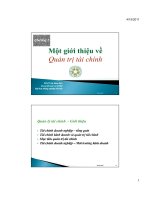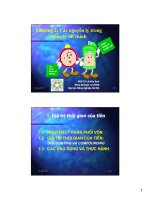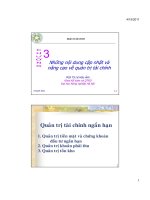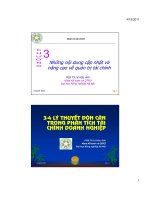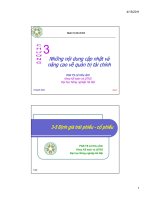ĐÁP ÁN SÁCH QUẢN TRỊ TÀI CHÍNH CUỐN TO DÀY uel KINH TE LUAT 4
Bạn đang xem bản rút gọn của tài liệu. Xem và tải ngay bản đầy đủ của tài liệu tại đây (618.66 KB, 23 trang )
Chapter 4
Analysis of Financial Statements
Learning Objectives
After reading this chapter, students should be able to:
Explain why ratio analysis is usually the first step in the analysis of a company’s financial
statements.
List the five groups of ratios, specify which ratios belong in each group, and explain what
information each group gives us about the firm’s financial position.
State what trend analysis is, and why it is important.
Describe how the basic Du Pont equation is used, and how it may be modified to form the
extended Du Pont equation, which includes the effect of financial leverage.
Explain “benchmarking” and its purpose.
List several limitations of ratio analysis.
Identify some of the problems with ROE that can arise when firms use it as a sole measure
of performance.
Identify some of the qualitative factors that must be considered when evaluating a
company’s financial performance.
Chapter 4: Analysis of Financial Statements
Learning Objectives
73
Lecture Suggestions
Chapter 4 shows how financial statements are analyzed to determine firms’ strengths and
weaknesses. On the basis of this information, management can take actions to exploit strengths
and correct weaknesses.
At Florida, we find a significant difference in preparation between our accounting and
non-accounting students. The accountants are relatively familiar with financial statements, and
they have covered in depth in their financial accounting course many of the ratios discussed in
Chapter 4. We pitch our lectures to the non-accountants, which means concentrating on the use
of statements and ratios, and the “big picture,” rather than on details such as seasonal
adjustments and the effects of different accounting procedures. Details are important, but so are
general principles, and there are courses other than the introductory finance course where details
can be addressed.
What we cover, and the way we cover it, can be seen by scanning the slides and
Integrated Case solution for Chapter 4, which appears at the end of this chapter solution. For
other suggestions about the lecture, please see the “Lecture Suggestions” in Chapter 2, where
we describe how we conduct our classes.
DAYS ON CHAPTER: 3 OF 58 DAYS (50-minute periods)
74
Lecture Suggestions
Chapter 4: Analysis of Financial Statements
4-1
Answers to End-of-Chapter Questions
The emphasis of the various types of analysts is by no means uniform nor should it be.
Management is interested in all types of ratios for two reasons. First, the ratios point out
weaknesses that should be strengthened; second, management recognizes that the other
parties are interested in all the ratios and that financial appearances must be kept up if the
firm is to be regarded highly by creditors and equity investors. Equity investors
(stockholders) are interested primarily in profitability, but they examine the other ratios
to get information on the riskiness of equity commitments. Long-term creditors are
more interested in the debt, TIE, and EBITDA coverage ratios, as well as the profitability
ratios. Short-term creditors emphasize liquidity and look most carefully at the current
ratio.
4-2
The inventory turnover ratio is important to a grocery store because of the much larger
inventory required and because some of that inventory is perishable. An insurance
company would have no inventory to speak of since its line of business is selling
insurance policies or other similar financial products—contracts written on paper and
entered into between the company and the insured. This question demonstrates that the
student should not take a routine approach to financial analysis but rather should
examine the business that he or she is analyzing.
4-3
Given that sales have not changed, a decrease in the total assets turnover means that the
company’s assets have increased. Also, the fact that the fixed assets turnover ratio
remained constant implies that the company increased its current assets. Since the
company’s current ratio increased, and yet, its cash and equivalents and DSO are
unchanged means that the company has increased its inventories.
4-4
Differences in the amounts of assets necessary to generate a dollar of sales cause asset
turnover ratios to vary among industries. For example, a steel company needs a greater
number of dollars in assets to produce a dollar in sales than does a grocery store chain.
Also, profit margins and turnover ratios may vary due to differences in the amount of
expenses incurred to produce sales. For example, one would expect a grocery store
chain to spend more per dollar of sales than does a steel company. Often, a large
turnover will be associated with a low profit margin, and vice versa.
Chapter 4: Analysis of Financial Statements
Answers and Solutions
75
4-5
Inflation will cause earnings to increase, even if there is no increase in sales volume.
Yet, the book value of the assets that produced the sales and the annual depreciation
expense remain at historic values and do not reflect the actual cost of replacing those
assets. Thus, ratios that compare current flows with historic values become distorted
over time. For example, ROA will increase even though those assets are generating the
same sales volume.
When comparing different companies, the age of the assets will greatly affect the
ratios. Companies with assets that were purchased earlier will reflect lower asset values
than those that purchased assets later at inflated prices. Two firms with similar physical
assets and sales could have significantly different ROAs. Under inflation, ratios will also
reflect differences in the way firms treat inventories. As can be seen, inflation affects
both income statement and balance sheet items.
4-6
ROE, using the extended Du Pont equation, is the return on assets multiplied by the
equity multiplier. The equity multiplier, defined as total assets divided by common
equity, is a measure of debt utilization; the more debt a firm uses, the lower its equity,
and the higher the equity multiplier. Thus, using more debt will increase the equity
multiplier, resulting in a higher ROE.
4-7
a. Cash, receivables, and inventories, as well as current liabilities, vary over the year for
firms with seasonal sales patterns. Therefore, those ratios that examine balance sheet
figures will vary unless averages (monthly ones are best) are used.
b. Common equity is determined at a point in time, say December 31, 2005. Profits are
earned over time, say during 2005. If a firm is growing rapidly, year-end equity will
be much larger than beginning-of-year equity, so the calculated rate of return on
equity will be different depending on whether end-of-year, beginning-of-year, or
average common equity is used as the denominator. Average common equity is
conceptually the best figure to use. In public utility rate cases, people are reported to
have deliberately used end-of-year or beginning-of-year equity to make returns on
equity appear excessive or inadequate. Similar problems can arise when a firm is
being evaluated.
4-8
76
Firms within the same industry may employ different accounting techniques that make it
difficult to compare financial ratios. More fundamentally, comparisons may be
Answers and Solutions
Chapter 4: Analysis of Financial Statements
misleading if firms in the same industry differ in their other investments. For example,
comparing Pepsico and Coca-Cola may be misleading because apart from their soft
drink business, Pepsi also owns other businesses, such as Frito-Lay.
4-9
The three components of the extended Du Pont equation are profit margin, assets
turnover, and the equity multiplier. One would not expect the three components of the
discount merchandiser and high-end merchandiser to be the same even though their
ROEs are identical. The discount merchandiser’s profit margin would be lower than the
high-end merchandiser, while the assets turnover would be higher for the discount
merchandiser than for the high-end merchandiser.
4-10
a.
b.
c.
d.
e.
f.
g.
h.
i.
j.
k.
l.
m.
n.
o.
p.
q.
r.
Total
Current Assets
Cash is acquired through issuance of additional
common stock.
+
Merchandise is sold for cash.
+
Federal income tax due for the previous year is paid.
A fixed asset is sold for less than book value.
+
A fixed asset is sold for more than book value.
+
Merchandise is sold on credit.
+
Payment is made to trade creditors for previous purchases.
A cash dividend is declared and paid.
–
Cash is obtained through short-term bank loans. +
Short-term notes receivable are sold at a discount. –
Marketable securities are sold below cost.
–
Advances are made to employees.
0
Current operating expenses are paid.
–
Short-term promissory notes are issued to trade creditors
in exchange for past due accounts payable.
0
10-year notes are issued to pay off accounts payable.
Total
Current Assets
A fully depreciated asset is retired.
0
Accounts receivable are collected.
0
Equipment is purchased with short-term notes.
0
Chapter 4: Analysis of Financial Statements
Current
Ratio
Effect on
Net Income
+
+
–
+
+
+
–
–
–
–
–
0
–
0
+
+
–
+
+
+
0
0
–
–
0
–
0
0
Current
Ratio
0
0
–
0
+
0
Effect on
Net Income
0
0
0
Answers and Solutions
0
0
77
s. Merchandise is purchased on credit.
t. The estimated taxes payable are increased.
78
Answers and Solutions
+
0
–
–
0
–
Chapter 4: Analysis of Financial Statements
Solutions of End-of-Chapter Problems
4-1
DSO = 40 days; S = $7,300,000; AR = ?
DSO =
40 =
AR
S
365
AR
$7,300,000/365
40 = AR/$20,000
AR = $800,000.
4-2
A/E = 2.4; D/A = ?
D
= 1A
D
= 1 A
1
A
E
1
2.4
D
= 0.5833= 58.33%.
A
4-3
ROA = 10%; PM = 2%; ROE = 15%; S/TA = ?; TA/E = ?
ROA = NI/A; PM = NI/S; ROE = NI/E.
ROA
NI/A
10%
S/TA
= PM × S/TA
= NI/S × S/TA
= 2% × S/TA
= TATO = 5.
ROE
= PM × S/TA × TA/E
Chapter 4: Analysis of Financial Statements
Answers and Solutions
79
NI/E
15%
15%
TA/E
4-4
= NI/S × S/TA × TA/E
= 2% × 5 × TA/E
= 10% × TA/E
= EM = 1.5.
TA = $10,000,000,000; CL = $1,000,000,000; LT debt = $3,000,000,000; CE =
$6,000,000,000; Shares outstanding = 800,000,000; P0 = $32; M/B = ?
Book value =
M/B =
4-5
$32.00
$7.50
$6,000,000,000
800,000,000
= $7.50.
= 4.2667.
EPS = $2.00; CFPS = $300; P/CF = 8.0× ; P/E = ?
P/CF = 8.0
P/$3.00
= 8.0
P = $24.00.
P/E = $24.00/$2.00 = 12.0× .
4-6
PM = 2%; EM = 2.0; Sales = $100,000,000; Assets = $50,000,000; ROE = ?
ROE = PM × TATO × EM
= NI/S × S/TA × A/E
= 2% × $100,000,00/$50,000,000 × 2
= 8%.
4-7
80
Step 1:Calculate total assets from information given.
Sales = $6 million.
Answers and Solutions
Chapter 4: Analysis of Financial Statements
3.2× = Sales/TA
3.2× =
$6,000,000
Assets
Assets = $1,875,000.
Step 2:Calculate net income.
There is 50% debt and 50% equity, so Equity = $1,875,000 × 0.5 = $937,500.
ROE = NI/S × S/TA × TA/E
0.12 = NI/$6,000,000 × 3.2 × $1,875,000/$937,500
0.12 =
6.4NI
$6,000,000
$720,000
= 6.4NI
$112,500 = NI.
4-8
ROA = 8%; net income = $600,000; TA = ?
ROA =
8%=
NI
TA
$600,000
TA
TA = $7,500,000.
To calculate BEP, we still need EBIT. To calculate EBIT construct a partial income
statement:
EBIT
Interest
EBT
Taxes (35%)
NI
BEP =
$1,148,077
225,000
$ 923,077
323,077
$ 600,000
($225,000 + $923,077)
(Given)
$600,000/0.65
EBIT
TA
Chapter 4: Analysis of Financial Statements
Answers and Solutions
81
=
$1,148,077
$7,500,000
= 0.1531 = 15.31%.
4-9
Stockholders’ equity = $3,750,000,000; M/B = 1.9; P = ?
Total market value = $3,750,000,000(1.9) = $7,125,000,000.
Market value per share = $7,125,000,000/50,000,000 = $142.50.
Alternative solution:
Stockholders’ equity = $3,750,000,000; Shares outstanding = 50,000,000; P = ?
Book value per share = $3,750,000,000/50,000,000 = $75.
Market value per share = $75(1.9) = $142.50.
4-10 We are given ROA = 3% and Sales/Total assets = 1.5× .
From the basic Du Pont equation: ROA = Profit margin × Total assets turnover
3% = Profit margin(1.5)
Profit margin = 3%/1.5 = 2%.
We can also calculate the company’s debt ratio in a similar manner, given the facts of the
problem. We are given ROA(NI/A) and ROE(NI/E); if we use the reciprocal of ROE we
have the following equation:
E NI E
D
E
= ×
and =1 − , so
A A NI
A
A
E
1
= 3% ×
A
0.05
E
= 60%.
A
D
=1 − 0.60= 0.40= 40%.
A
Alternatively, using the extended Du Pont equation:
82
Answers and Solutions
Chapter 4: Analysis of Financial Statements
ROE
= ROA × EM
5% = 3% × EM
EM = 5%/3% = 5/3 = TA/E.
Take reciprocal: E/TA = 3/5 = 60%; therefore, D/A = 1 – 0.60 = 0.40 = 40%.
Thus, the firm’s profit margin = 2% and its debt ratio = 40%.
4-11 TA = $30,000,000,000; EBIT/TA = 20%; TIE = 8; DA = $3,200,000,000; Lease
payments = $2,000,000,000; Principal payments = $1,000,000,000; EBITDA coverage = ?
EBIT/$30,000,000,000
= 0.2
EBIT = $6,000,000,000.
8 = EBIT/INT
8 = $6,000,000,000/INT
INT = $750,000,000.
EBITDA
= EBIT + DA
= $6,000,000,000 + $3,200,000,000
= $9,200,000,000.
EBITDA coverage ratio
=
EBITDA+ Leasepayments
INT + Princ.pmts+ Leasepmts
=
$9,200,000,000+ $2,000,000,000
$750,000,000+ $1,000,000,000+ $2,000,000,000
=
$11,200,000,000
$3,750,000,000
= 2.9867.
4-12 TA = $12,000,000,000; T = 40%; EBIT/TA = 15%; ROA = 5%; TIE = ?
EBIT
= 0.15
$12,000,000,000
EBIT = $1,800,000,000.
Chapter 4: Analysis of Financial Statements
Answers and Solutions
83
NI
= 0.05
$12,000,000,000
NI = $600,000,000.
Now use the income statement format to determine interest so you can calculate the
firm’s TIE ratio.
INT = EBIT – EBT
= $1,800,000,000 – $1,000,000,000
EBIT
$1,800,000,000 See above.
INT
800,000,000
EBT
$1,000,000,000 EBT = $600,000,000/0.6
Taxes (40%)
400,000,000
NI
$ 600,000,000 See above.
TIE
= EBIT/INT
= $1,800,000,000/$800,000,000
= 2.25.
4-13 TIE = EBIT/INT, so find EBIT and INT.
Interest = $500,000 × 0.1 = $50,000.
Net income = $2,000,000 × 0.05 = $100,000.
Pre-tax income (EBT) = $100,000/(1 – T) = $100,000/0.7 = $142,857.
EBIT = EBT + Interest = $142,857 + $50,000 = $192,857.
TIE = $192,857/$50,000 = 3.86× .
4-14 ROE
= Profit margin × TA turnover × Equity multiplier
= NI/Sales × Sales/TA × TA/Equity.
84
Answers and Solutions
Chapter 4: Analysis of Financial Statements
Now we need to determine the inputs for the extended Du Pont equation from the data
that were given. On the left we set up an income statement, and we put numbers in it on
the right:
Sales (given)
$10,000,000
– Cost
na
EBIT (given)
$ 1,000,000
– INT (given)
300,000
EBT
$ 700,000
– Taxes (34%)
238,000
NI
$ 462,000
Now we can use some ratios to get some more data:
Total assets turnover = 2 = S/TA; TA = S/2 = $10,000,000/2 = $5,000,000.
D/A = 60%; so E/A = 40%; and, therefore,
Equity multiplier = TA/E = 1/(E/A) = 1/0.4 = 2.5.
Now we can complete the extended Du Pont equation to determine ROE:
ROE = $462,000/$10,000,000 × $10,000,000/$5,000,000 × 2.5 = 0.231 = 23.1%.
4-15 Currently, ROE is ROE1 = $15,000/$200,000 = 7.5%.
The current ratio will be set such that 2.5 = CA/CL. CL is $50,000, and it will not
change, so we can solve to find the new level of current assets: CA = 2.5(CL) =
2.5($50,000) = $125,000. This is the level of current assets that will produce a current
ratio of 2.5× .
At present, current assets amount to $210,000, so they can be reduced by $210,000 –
$125,000 = $85,000. If the $85,000 generated is used to retire common equity, then the
new common equity balance will be $200,000 – $85,000 = $115,000.
Assuming that net income is unchanged, the new ROE will be ROE 2 =
$15,000/$115,000 = 13.04%. Therefore, ROE will increase by 13.04% – 7.50% =
5.54%.
The new CA level is $125,000; CL remain at $50,000; and the new Inventory level =
$150,000 – $85,000 = $65,000. Thus, the new quick ratio is calculated as follows:
Chapter 4: Analysis of Financial Statements
Answers and Solutions
85
New quick ratio =
=
CA − Inv
CL
$125,000− $65,000
$50,000
= 1.2× .
4-16 Known data:
TA = $1,000,000; Int. rate = 8%; T = 40%; BEP = 0.2 = EBIT/Total assets, so EBIT =
0.2($1,000,000) = $200,000; D/A = 0.5 = 50%, so Equity = $500,000.
EBIT
Interest
EBT
Tax (40%)
NI
ROE =
NI
=
Equity
D/A = 0%
$200,000
0
$200,000
80,000
$120,000
D/A = 50%
$200,000
40,000*
$160,000
64,000
$ 96,000
$120,000
= 12%
$1,000,000
$96,000
= 19.2%
$500,000
Difference in ROE = 19.2% – 12.0% = 7.2%.
*If D/A = 50%, then half of the assets are financed by debt, so Debt = $500,000. At an
8% interest rate, INT = $40,000.
4-17 Statement a is correct. Refer to the solution setup for Problem 4-16 and think about it this
way: (1) Adding assets will not affect common equity if the assets are financed with debt.
(2) Adding assets will cause expected EBIT to increase by the amount EBIT =
BEP(added assets). (3) Interest expense will increase by the amount Int. rate(added
assets). (4) Pre-tax income will rise by the amount (added assets)(BEP – Int. rate).
Assuming BEP > Int. rate, if pre-tax income increases so will net income. (5) If expected
net income increases but common equity is held constant, then the expected ROE will
also increase. Note that if Int. rate > BEP, then adding assets financed by debt would
86
Answers and Solutions
Chapter 4: Analysis of Financial Statements
lower net income and thus the ROE. Therefore, Statement a is true—if assets financed by
debt are added, and if the expected BEP on those assets exceeds the interest rate on debt,
then the firm’s ROE will increase.
Statements b, c, and d are false, because the BEP ratio uses EBIT, which is calculated
before the effects of taxes or interest charges are felt. Of course, Statement e is also
false.
4-18 TA = $5,000,000,000; T = 40%; EBIT/TA = 10%; ROA = 5%; TIE ?
EBIT
= 0.10
$5,000,000
,000
EBIT = $500,000,000.
NI
= 0.05
$5,000,000
,000
NI = $250,000,000.
Now use the income statement format to determine interest so you can calculate the
firm’s TIE ratio.
INT = EBIT – EBT
= $500,000,000 - $416,666,667
EBIT
$500,000,000 See above.
INT
83,333,333
EBT
$416,666,667 EBT = $250,000,000/0.6
Taxes (40%) 166,666,667
NI
$250,000,000 See above.
TIE = EBIT/INT
= $500,000,000/$83,333,333
= 6.0.
4-19 Present current ratio =
$1,312,500
= 2.5.
$525,000
Minimum current ratio =
$1,312,500
+ ∆NP
$525,000+ ∆NP
Chapter 4: Analysis of Financial Statements
= 2.0.
Answers and Solutions
87
$1,312,500 + ∆NP = $1,050,000 + 2∆NP
∆NP = $262,500.
Short-term debt can increase by a maximum of $262,500 without violating a 2 to 1 current
ratio, assuming that the entire increase in notes payable is used to increase current assets.
Since we assumed that the additional funds would be used to increase inventory, the
inventory account will increase to $637,500 and current assets will total $1,575,000, and
current liabilities will total $787,500.
4-20 Step 1:Solve for current annual sales using the DSO equation:
55 = $750,000/(Sales/365)
55Sales = $273,750,000
Sales = $4,977,272.73.
Step 2:If sales fall by 15%, the new sales level will be $4,977,272.73(0.85) =
$4,230,681.82. Again, using the DSO equation, solve for the new accounts
receivable figure as follows:
35= AR/($4,230,681.82/365)
35= AR/$11,590.91
AR
= $405,681.82 ≈ $405,682.
4-21
The current EPS is $2,000,000/500,000 shares or $4.00. The current P/E ratio is then
$40/$4 = 10.00. The new number of shares outstanding will be 650,000. Thus, the new
EPS = $3,250,000/650,000 = $5.00. If the shares are selling for 10 times EPS, then they
must be selling for $5.00(10) = $50.
4-22 1. Total debt = (0.50)(Total assets) = (0.50)($300,000) = $150,000.
2. Accounts payable = Total debt – Long-term debt
= $150,000 – $60,000
= $90,000.
88
Answers and Solutions
Chapter 4: Analysis of Financial Statements
3. Common stock
=
Total liabilitie
s
andequity
– Debt – Retained earnings
= $300,000 – $150,000 – $97,500 = $52,500.
4. Sales = (1.5)(Total assets) = (1.5)($300,000) = $450,000.
5. Inventories = Sales/5 = $450,000/5 = $90,000.
6. Accounts receivable
= (Sales/365)(DSO) = ($450,000/365)(36.5) = $45,000.
7. Cash + Accounts receivable + Inventories
= (1.8)(Accounts payable)
Cash + $45,000 + $90,000 = (1.8)($90,000)
Cash + $135,000 = $162,000
Cash = $27,000.
8. Fixed assets = Total assets – (Cash + Accts rec. + Inventories)
= $300,000 – ($27,000 + $45,000 + $90,000)
= $138,000.
9. Cost of goods sold = (Sales)(1 – 0.25) = ($450,000)(0.75) = $337,500.
4-23 a. (Dollar amounts in thousands.)
Industry
Firm Average
Currentassets
Currentliabilitie
s
Currentassets− Inventorie
s
Currentliabilitie
s
DS
=
O
Accountsreceivable
Sales/365
Sales
Inventorie
s
Sales
Total assets
=
=
=
=
=
Chapter 4: Analysis of Financial Statements
$655,000
$330,000
$655,000− $241,500
$330,000
$336,000
$4,404.11
$1,607,500
$241,500
$1,607,500
$947,500
= 1.98×
2.0×
= 1.25×
1.3×
76.3
days
35
days
= 6.66×
6.7×
= 1.70×
3.0×
=
Answers and Solutions
89
Netincome
Sales
Netincome
Total assets
Netincome
Commonequity
Total debt
Total assets
=
=
=
=
$27,300
$1,607,500
$27,300
$947,500
$27,300
$361,000
$586,500
$947,500
= 1.7%
1.2%
= 2.9%
3.6%
= 7.6%
9.0%
= 61.9%
60.0%
b. For the firm,
ROE = PM × T.A. turnover × EM = 1.7% × 1.7 ×
$947,500
= 7.6%.
$361,000
For the industry, ROE = 1.2% × 3 × 2.5 = 9%.
Note: To find the industry ratio of assets to common equity, recognize that 1 – (Total
debt/Total assets) = Common equity/Total assets. So, Common equity/Total assets =
40%, and 1/0.40 = 2.5 = Total assets/Common equity.
c. The firm’s days sales outstanding is more than twice as long as the industry average,
indicating that the firm should tighten credit or enforce a more stringent collection
policy. The total assets turnover ratio is well below the industry average so sales
should be increased, assets decreased, or both. While the company’s profit margin is
higher than the industry average, its other profitability ratios are low compared to the
industry—net income should be higher given the amount of equity and assets.
However, the company seems to be in an average liquidity position and financial
leverage is similar to others in the industry.
d. If 2005 represents a period of supernormal growth for the firm, ratios based on this
year will be distorted and a comparison between them and industry averages will
have little meaning. Potential investors who look only at 2005 ratios will be misled,
and a return to normal conditions in 2006 could hurt the firm’s stock price.
4-24 a.
90
Answers and Solutions
Industry
Firm Average
Chapter 4: Analysis of Financial Statements
Current ratio
=
Currentassets
Currentliabilitie
s
=
$303
$111
= 2.73×
2×
Debtto
totalassets
=
Debt
Total assets
=
$135
$450
= 30.00%
30.00
%
Timesinterest
earned
=
=
$49.5
$4.5
=
EBITDA
coverage
=
EBIT
Interest
EBITDA+ Leasepymts
INT + Princ. + Lease
pymts pymts
=
$61.5
$6.5
= 9.46×
Inventory
turnover
=
Sales
Inventorie
s
=
$795
$159
=
5×
10×
DSO
=
=
$66
$795/365
=
30.3
days
24
days
F. A.
turnover
=
T. A.
turnover
=
Profit margin
=
Returnon
totalassets
=
Returnon
commonequity
=
Alternatively, ROE =
Accountsreceivable
Sales/365
Sales
Net fixedassets
Sales
Total assets
Netincome
Sales
Netincome
Total assets
ROA × EM
$795
$147
$795
$450
$27
$795
$27
$450
=
=
=
=
=
6% ×
1.4286
Netincome
$27
= $315 = 8.57% ≈
Equity
11×
7×
9×
= 5.41×
6×
= 1.77×
3×
= 3.40%
3.00%
= 6.00%
9.00%
= 8.57%
12.90
%
8.6%.
b. ROE = Profit margin × Total assets turnover × Equity multiplier
=
Total assets
Netincome
Sales
×
× Commonequity
Sales
Total assets
=
$27
$795
$450
×
×
= 3.4% ×
$795
$450
$315
Chapter 4: Analysis of Financial Statements
1.77 × 1.4286 = 8.6%.
Answers and Solutions
91
Firm
3.4%
1.77×
1.4286
Profit margin
Total assets turnover
Equity multiplier
*1–
D
TA
=
Industry
3.0%
3.0×
1.43*
Comment
Good
Poor
O.K.
E
TA
1 – 0.30 = 0.7
EM =
TA
E
=
1
0.7
= 1.43.
Alternatively, EM = ROE/ROA = 12.9%/9% = 1.43.
c. Analysis of the extended Du Pont equation and the set of ratios shows that the
turnover ratio of sales to assets is quite low. Either sales should be higher given the
present level of assets, or the firm is carrying more assets than it needs to support its
sales.
d. The comparison of inventory turnover ratios shows that other firms in the industry
seem to be getting along with about half as much inventory per unit of sales as the
firm. If the company’s inventory could be reduced, this would generate funds that
could be used to retire debt, thus reducing interest charges and improving profits, and
strengthening the debt position. There might also be some excess investment in fixed
assets, perhaps indicative of excess capacity, as shown by a slightly lower-thanaverage fixed assets turnover ratio. However, this is not nearly as clear-cut as the
overinvestment in inventory.
e. If the firm had a sharp seasonal sales pattern, or if it grew rapidly during the year,
many ratios might be distorted. Ratios involving cash, receivables, inventories,
and current liabilities, as well as those based on sales, profits, and common equity,
could be biased. It is possible to correct for such problems by using average
rather than end-of-period figures.
92
Answers and Solutions
Chapter 4: Analysis of Financial Statements
Comprehensive/Spreadsheet Problem
Note to Instructors:
The solution to this problem is not provided to students at the back of their text.
Instructors can access the Excel file on the textbook’s Web site or the Instructor’s
Resource CD.
4-25
Chapter 4: Analysis of Financial Statements
Integrated Case
93
a. Corrigan's liquidity position has improved from 2004 to 2005; however, its current
ratio is still below the industry average of 2.7.
b. Corrigan's inventory turnover, fixed assets turnover, and total assets turnover have
improved from 2004 to 2005; however, they are still below industry averages. The
firm's days sales outstanding has increased from 2004 to 2005—which is bad. In
2004, its DSO was close to the industry average. In 2005, its DSO is somewhat
higher. If the firm's credit policy has not changed, it needs to look at its receivables
and determine whether it has any uncollectibles. If it does have uncollectible
receivables, this will make its current ratio look worse than what was calculated
above.
c. Corrigan's debt ratio has increased from 2004 to 2005, which is bad. In 2004, its debt
ratio was right at the industry average, but in 2005 it is higher than the industry
average. Given its weak current and asset management ratios, the firm should
strengthen its balance sheet by paying down liabilities.
d. Corrigan's profitability ratios have declined substantially from 2004 to 2005, and they
are substantially below the industry averages. Corrigan needs to reduce its costs,
increase sales, or both.
e. Corrigan's P/E ratio has increased from 2004 to 2005, but only because its net income
has declined significantly from the prior year. Its P/CF ratio has declined from the
prior year and is well below the industry average. These ratios reflect the same
information as Corrigan's profitability ratios. Corrigan needs to reduce costs to
increase profit, lower its debt ratio, increase sales, and improve its asset management.
f.
Looking at the extended Du Pont equation, Corrigan's profit margin is significantly
lower than the industry average and it has declined substantially from 2004 to 2005.
The firm's total assets turnover has improved slightly from 2004 to 2005, but it's still
94
Integrated Case
Chapter 4: Analysis of Financial Statements
below the industry average. The firm's equity multiplier has increased from 2004 to
2005 and is higher than the industry average. This indicates that the firm's debt ratio
is increasing and it is higher than the industry average.
Corrigan should increase its net income by reducing costs, lower its debt ratio,
and improve its asset management by either using less assets for the same amount of
sales or increase sales.
g. If Corrigan initiated cost-cutting measures, this would increase its net income. This
would improve its profitability ratios and market value ratios. If Corrigan also
reduced its levels of inventory, this would improve its current ratio—as this would
reduce liabilities as well. This would also improve its inventory turnover and total
assets turnover ratio. Reducing costs and lowering inventory would also improve its
debt ratio.
Chapter 4: Analysis of Financial Statements
Integrated Case
95


